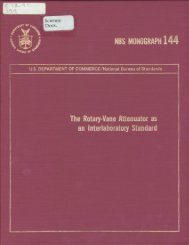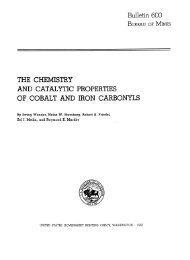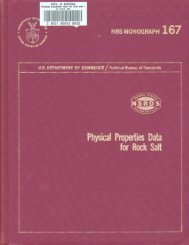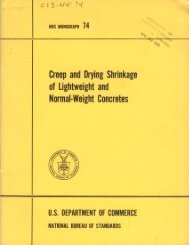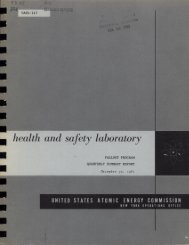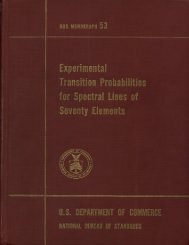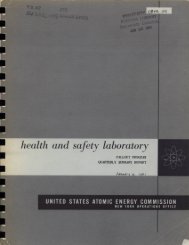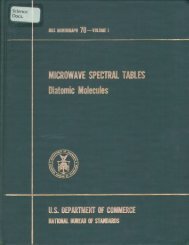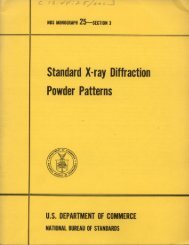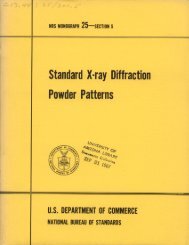Soil characteristics:+ 6 to 0 ft: C<strong>in</strong>der fill.+ 2 to +J ! : Water table at low tide. River wateris nonbmekish fresh water. Mean low water at 0ft,0 to 48: S<strong>of</strong>t black organic silt.48 to —86: Black organic silt with some f<strong>in</strong>esand and clay <strong>in</strong>term<strong>in</strong>gled.— 86 to — 88: F<strong>in</strong>e brown silty sand, trace <strong>of</strong> mica.— 88 to —91 : Gray to brown coarse sand and river— 91 lo --II4: Sand HIM! silty sand underla<strong>in</strong> byday.Condition oj piles:Seven full lengths and the <strong>in</strong>terlock edges <strong>of</strong> 70piles were <strong>in</strong>spected. All the piles were <strong>in</strong> excellentcondition from the mud l<strong>in</strong>e (elevation 0 ft where thenatural soil starts) down to the bottom <strong>of</strong> the piles.The piles are to be reused <strong>in</strong>. the new dock structureat the same site.+ 10 to 0 ft: Moderate corrosion on surfacesexposed to water and the atmosphere on the riverside, and to c<strong>in</strong>der fill, water and atmosphere on theland side. Surfaces were uniformily corroded, theorig<strong>in</strong>al thickness <strong>of</strong> the piles be<strong>in</strong>g reduced by anaverage not exceed<strong>in</strong>g 10 percent. Widely scatteredpits present; most <strong>of</strong> the pits had depths less than75 mils, but a few had depths between 75 to 150mils.0 to bottom <strong>of</strong> piles: Accumulation <strong>of</strong> slick clayover most <strong>of</strong> the surface. No measurable pits.Mill scale <strong>in</strong>tact over more than 90 percent <strong>of</strong> thesurfaces.h. Lumber River Near Boardman, North Carol<strong>in</strong>aHistory:The North Carol<strong>in</strong>a State Highway Departmentextracted 120 piles which formed a rectangularshapedc<strong>of</strong>ferdam for a bridge support over theLumber River near Boardman, N.C. The structurewas removed <strong>in</strong> connection with road improvementswhich required replacement <strong>of</strong> the old bridge.The steel piles were 20-ft lengths <strong>of</strong> <strong>in</strong>terlock<strong>in</strong>gI-beams hav<strong>in</strong>g a driv<strong>in</strong>g width <strong>of</strong> 8 <strong>in</strong>. and a wallthickness <strong>of</strong> 0.25 <strong>in</strong>. The corners <strong>of</strong> the c<strong>of</strong>ferdamconsisted <strong>of</strong> steel angles to which <strong>in</strong>terlock sections<strong>of</strong> pil<strong>in</strong>gs were attached bjr steel rivets, spaced 9 <strong>in</strong>.apart.Date piles driven: 1921Date piles pulled: December 1958Age <strong>of</strong> pil<strong>in</strong>g: 37 yearsPil<strong>in</strong>g exposed: 2.5 ft above ground to 17.5 ft belowthe ground l<strong>in</strong>e ( + 2.5 to —17.5 ft). The portion <strong>of</strong>the piles above the ground l<strong>in</strong>e was subjected topartial or total immersion from water <strong>of</strong> the LumberRiver about 50 percent <strong>of</strong> the year, and to theatmosphere when the river was dry dur<strong>in</strong>g therema<strong>in</strong><strong>in</strong>g half year. The sides <strong>of</strong> the pil<strong>in</strong>gs whichwere exposed to the excavated side <strong>of</strong> the c<strong>of</strong>ferdamwere <strong>in</strong> contact with concrete, except fort he bottom3 ft which was entirely surrounded by soil.10Soil characteristics:0 (ground l<strong>in</strong>e) to —8 ft: Gray f<strong>in</strong>e sandy loam,— 8 to —14: Bluish-gray plastic silty clay.— 14 to —17.5: Gray-black f<strong>in</strong>e sandy loam conta<strong>in</strong><strong>in</strong>g appreciable gravel.3--...10.. ..ElevationftSoil resistivity and pHResistivityOhm-cm1,2401, 1004, 900pE3. 42.35. 9Condition oj piles:Visual <strong>in</strong>spection <strong>of</strong> the pil<strong>in</strong>gs revealed that theyhad all corroded to about the same extent. Asection <strong>of</strong> the c<strong>of</strong>ferdam consist<strong>in</strong>g <strong>of</strong> two fulllengths <strong>of</strong> piles and a corner angle was shipped tothe laboratory for further exam<strong>in</strong>ation.Practically no mill scale rema<strong>in</strong>ed on the pilesurfaces <strong>in</strong> the zone extend<strong>in</strong>g from 3 ft below theground l<strong>in</strong>e to the top <strong>of</strong> the piles. In the lower zones,approximately 20 percent <strong>of</strong> the mill scale was<strong>in</strong>tact.Th<strong>in</strong> concrete deposits were found on the surfaceswhere the steel had been <strong>in</strong> contact with concreteon the excavated side <strong>of</strong> the c<strong>of</strong>ferdam. There wasa thick scale <strong>of</strong> rusted corrosion products and soilover the entire surface exposed directly to the soilenvironments. The scale was flakey and easilyremoved by scrap<strong>in</strong>g.The follow<strong>in</strong>g conditions were observed afterthe piles were cleaned by sandblast<strong>in</strong>g:+ 2.5 to 0 ft: Section exposed to total or partialwater immersion, or atmosphere. Uniform corrosion<strong>of</strong> surface. Measurements <strong>of</strong> the cross section <strong>in</strong>the top 6 <strong>in</strong>. <strong>of</strong> the piles (elevation +2.5 to +2.0)showed a m<strong>in</strong>imum thickness <strong>of</strong> 0.06 <strong>in</strong>. <strong>in</strong> places.This represents a loss <strong>of</strong> 76 percent <strong>in</strong> the orig<strong>in</strong>alpile thickness. The maximum thickness measuredon uncorrpded surfaces near the bottom <strong>of</strong> the pileswas 0.26 <strong>in</strong>. Piles <strong>in</strong> the zone between +2.0 ft tothe ground l<strong>in</strong>e showed a maximum reduction <strong>in</strong>thickness <strong>of</strong> 60 percent.0 to —0.5: This area showed an amount <strong>of</strong> corrosion similar to that on the adjacent areas above.The orig<strong>in</strong>al pile thickness <strong>in</strong> this zone was reducedby a maximum <strong>of</strong> 40 percent, and isolated pits ranged<strong>in</strong> depth up to 60 mils.— 0.5 to —1.0: The pattern <strong>of</strong> corrosion <strong>in</strong> thiszone was similar to that noted above. Maximumreduction <strong>in</strong> pile thickness was 36 percent.— 1.0 to —3.0: Uniform corrosion, general roughen<strong>in</strong>g <strong>of</strong> surface, numerous shallow pits and manyisolated pits up to 60 mils. Maximum reduction <strong>in</strong>cross section was 28 percent.— 3 to —17.5: In this zone the condition <strong>of</strong> thesurface was similar to that described above, but wasless severely corroded. Many isolated pits measuredup to 30 mils <strong>in</strong> depth, and relatively few up to 60
mils. A maximum reduction <strong>in</strong> pile cross section <strong>of</strong>12 percent was noted <strong>in</strong> this zone.The corner angle along the entire pil<strong>in</strong>g sectionshowed the same extent <strong>of</strong> corrosion as the I-beams,All rivets were uniformly corroded. The orig<strong>in</strong>alcontour <strong>of</strong> the rivets was <strong>in</strong>tact.A 3-ft corner section <strong>of</strong> the pil<strong>in</strong>g exposed immediately below the soil l<strong>in</strong>e is shown <strong>in</strong> figure 4.4.2. <strong>Pil<strong>in</strong>gs</strong> Exposed <strong>in</strong> Excavationsa. Memphis Floodwall, Memphis, TennesseeHistory:Excavations were made to expose pil<strong>in</strong>gs at twolocations on the river side <strong>of</strong> the Memphis Floodwall.The walls consist <strong>of</strong> type Z 27 sheet pil<strong>in</strong>gs hav<strong>in</strong>gan 18-<strong>in</strong>. driv<strong>in</strong>g width, and a thickness <strong>of</strong> %-<strong>in</strong>. atthe web and flanges. The pil<strong>in</strong>gs at station 56+14were given two coats <strong>of</strong> cold applied coal-tar-baseenamel before driv<strong>in</strong>g, and the pil<strong>in</strong>gs at station60+00 were uncoated.Date piles driven: November 1953Date <strong>of</strong> <strong>in</strong>spection: March 1960Age <strong>of</strong> pil<strong>in</strong>g: 6.3 yearsCondition <strong>of</strong> piles:The coal tar coat<strong>in</strong>g was <strong>in</strong>tact over the entiresurface except at elevation 220.5 to 219.5 ft wherethe coat<strong>in</strong>g was damaged <strong>in</strong> an area 1-ft <strong>in</strong> verticaldirection by 1-<strong>in</strong>. <strong>in</strong> width. The maximum depth <strong>of</strong>pitt<strong>in</strong>g <strong>of</strong> the steel exposed by the damaged coat<strong>in</strong>gwas 35 mils (fig. 5). The steel beneath the rest <strong>of</strong>the coat<strong>in</strong>g was unaffected by corrosion and the millscale was <strong>in</strong>tact.STATION 60+00Pil<strong>in</strong>g exposed: An 8-ft width <strong>of</strong> the floodwall wasexposed between elevation 222.5 and 213.5 ft.Surface elevation: 226.5 ftWater table elevation: Below 213.5 ftSoil characteristics:226.5 to 224 ft: Brown lean clay.224 to 222.5: Gray silty clay.222.5 to 218.5: Friable brown silty clay. Somec<strong>in</strong>ders mixed with the clay between 223 and 220 ft.218.5 to 213.5: Friable and plastic reddish brownsilty clay. Very impervious to water.STATION 56+14Pil<strong>in</strong>g exposed: An 8-ft width <strong>of</strong> the floodwall wasexposed between elevation 223.0 to 216.5 ft.Surface elevation: 228 ftWater table elevation: 217.5 ftSoil characteristics:228 to 223 ft: Friable brown lean clay.223 to 221.5: Plastic and friable gray silty clay.221.5 to 217.5: Plastic light brown clayey silt.Excessive water below 219.5 ft.217.5 to 216.5: Tight gray clay mixed with decomposed wood.Elevationft228 to 218______-_228 to 208—,-----228 to 198-.-----223— -----------222______________221______________221______________219.5------------219._______--__-_218-—---, ------216.5____________Soil resistivity and pHResistivityOhm-cmM<strong>in</strong> 1,220 (4-p<strong>in</strong>). -----------Max 8,600 (4-p<strong>in</strong>) _-__..______Avg 4,400 (4-p<strong>in</strong>) ___ _____ _M<strong>in</strong> 960 (4-p<strong>in</strong>). _____.__-_Max 6,900 (4-p<strong>in</strong>) ___________Avg 2,600 (4-p<strong>in</strong>). ___________M<strong>in</strong> 1,030 (4-p<strong>in</strong>)____________Max 3,400 ( 4-p<strong>in</strong>) ___ _________Avg 1,850 (4-p<strong>in</strong>)___ ________1,900 (Shepard Canes) _ _ _3,100 (Shepard Canes) _ _2,240 (Laboratory) ______2,300 (Shepard Canes) ___1,700 (Shepard Canes) _ _1,410 (Laboratory) _2,200 (Shepard Canes) __1,000 (Shepard Canes) _ _ _pH7. 87. 611Elevationft226.5 to 216.5___.226.5 to 206.5___._.226.5 to 196.5___._222.. _____________221______________221... .. __________219.5- --_.-_--_-_218.5217__-___________214.._. -._______-213.5-... ________Soil resistivity and pHResistivityOhm- cmM<strong>in</strong> 2, 1 80 (4-p<strong>in</strong>) _ _ __________Max 5,700 (4-p<strong>in</strong>) ____.__.._ .. _Avg 4,100 (4-p<strong>in</strong>)... _______.._M<strong>in</strong> 1,920 (4-p<strong>in</strong>) _____________Max 7,900 (4-p<strong>in</strong>) ____________Avg 4,200 (4-p<strong>in</strong>) ____________M<strong>in</strong> 1,030 (4-p<strong>in</strong>) __ __._Max 2,300 (4-pm)_______.-.__Avg 1,650 (4~p<strong>in</strong>)____________3,200 (Shepard Canes) ___2,500 (Shepard Canes). __2,200 (Laboratory) _______2,600 (Shepard Canes) _ _ .2, 100 (Shepard Canes) _ _ _1,690 (Laboratory) _______1,630 (Laboratory) _______1,500 (Shepard Canes)___pH6. 87. 87.5Condition <strong>of</strong> piles:The entire surface <strong>of</strong> the pil<strong>in</strong>gs was <strong>in</strong> excellentcondition. More than 90 percent <strong>of</strong> the mill scalewas <strong>in</strong>tact. There was very slight uniform metalattack <strong>in</strong> small localized areas. No measurable pitswere found on the entire surface. From elevation218 to the bottom <strong>of</strong> the excavated pit, the clayadhered very tightly to the pil<strong>in</strong>g. On removal,the soil peeled <strong>of</strong>f <strong>in</strong> layers leav<strong>in</strong>g free water on thesteel surface.A 2 ft by 1 ft section removed from the pile isannti^^n <strong>in</strong> •RnciiTo £.



